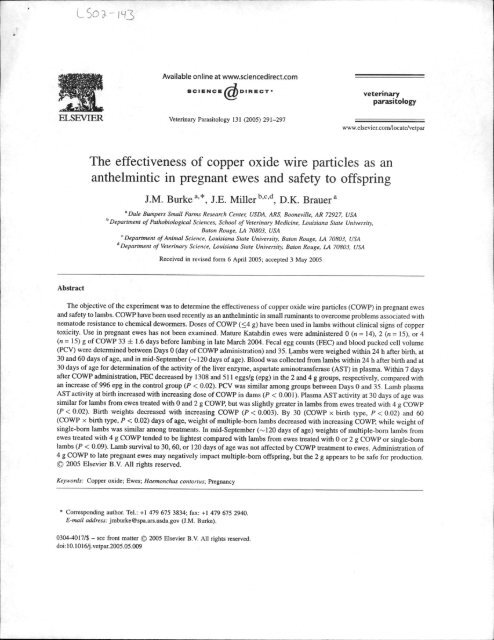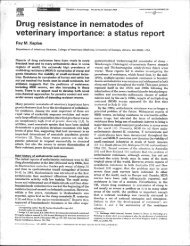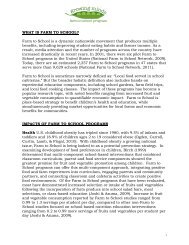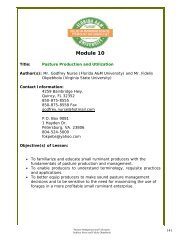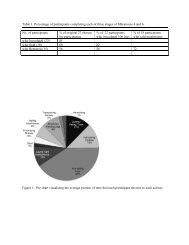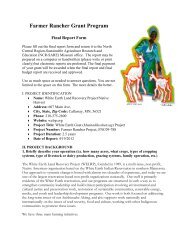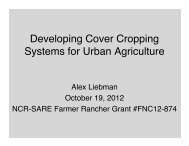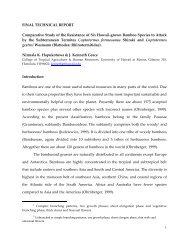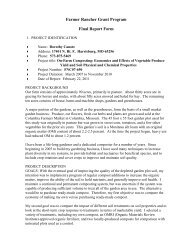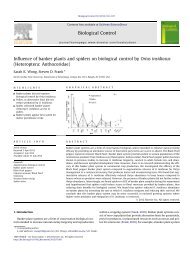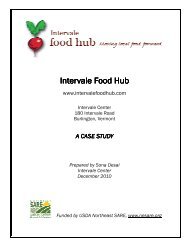The effectiveness of copper oxide wire particles as an anthelmintic ...
The effectiveness of copper oxide wire particles as an anthelmintic ...
The effectiveness of copper oxide wire particles as an anthelmintic ...
Create successful ePaper yourself
Turn your PDF publications into a flip-book with our unique Google optimized e-Paper software.
LSo^-iw3<br />
Available online at www '.sciencedirect.com<br />
8CIEI N CE @<br />
DIRECT*<br />
veterinary<br />
par<strong>as</strong>itology<br />
ELSEVIER Veterinary Par<strong>as</strong>itology 13<br />
1 (2005) 291-297 = ^ = =<br />
www.elsevier.com/locate/vetpar<br />
<strong>The</strong> <strong>effectiveness</strong> <strong>of</strong> <strong>copper</strong> <strong>oxide</strong> <strong>wire</strong> <strong>particles</strong> <strong>as</strong> <strong>an</strong><br />
<strong>an</strong>thelmintic in pregn<strong>an</strong>t ewes <strong>an</strong>d safety to <strong>of</strong>fspring<br />
J.M. Burke 3 *, J.E. Miller b ' c ' d , D.K. Brauer a<br />
'Dale Bumpers Small Farms Research Center, USDA, ARS, Booneville, AR 72927, USA<br />
Department <strong>of</strong> Pathobiological Sciences, School <strong>of</strong> Veterinary Medicine, Louisi<strong>an</strong>a State University,<br />
Baton Rouge, LA 70803, USA<br />
c Department <strong>of</strong> Animal Science, Louisi<strong>an</strong>a State University, Baton Rouge, LA 70803, USA<br />
d Department <strong>of</strong> Veterinary Science, Louisi<strong>an</strong>a State University, Baton Rouge, LA 70803, USA<br />
Received in revised form 6 April 2005; accepted 3 May 2005<br />
Abstract<br />
<strong>The</strong> objective <strong>of</strong> the experiment w<strong>as</strong> to determine the <strong>effectiveness</strong> <strong>of</strong> <strong>copper</strong> <strong>oxide</strong> <strong>wire</strong> <strong>particles</strong> (COWP) in pregn<strong>an</strong>t ewes<br />
<strong>an</strong>d safety to lambs. COWP have been used recently <strong>as</strong> <strong>an</strong> <strong>an</strong>thelmintic in small rumin<strong>an</strong>ts to overcome problems <strong>as</strong>sociated with<br />
nematode resist<strong>an</strong>ce to chemical dewormers. Doses <strong>of</strong> COWP (
292 J.M. Burke et al./Veterinary Par<strong>as</strong>itology 131 (2005) 291-297<br />
1. Introduction<br />
Options for g<strong>as</strong>trointestinal par<strong>as</strong>ite control for<br />
small rumin<strong>an</strong>ts are limited because <strong>of</strong> the rapidly<br />
developing resist<strong>an</strong>ce <strong>of</strong> nematodes to chemical<br />
dewormers (Miller <strong>an</strong>d Craig, 1996; Zajac <strong>an</strong>d Gipson,<br />
2000; Terrill et al., 2001; Mortensen et al., 2003). Other<br />
me<strong>an</strong>s <strong>of</strong> par<strong>as</strong>ite control have become necessary.<br />
Copper <strong>oxide</strong> <strong>wire</strong> <strong>particles</strong> (COWP) have been used in<br />
lambs to reduce infection with Haemonchus contortus<br />
(B<strong>an</strong>g et al., 1990; Knox, 2002; Burke et al., 2004). No<br />
clinical signs <strong>of</strong> <strong>copper</strong> toxicity have been reported<br />
when administering less th<strong>an</strong> 6 g <strong>of</strong> COWP to lambs or<br />
10 g COWP to ewes although liver concentrations <strong>of</strong><br />
<strong>copper</strong> were elevated in ewes (Suttle, 1987). <strong>The</strong>re w<strong>as</strong><br />
a linear incre<strong>as</strong>e with dose <strong>of</strong> COWP (0-6 g) in<br />
concentrations <strong>of</strong> <strong>copper</strong> in the liver, but all levels were<br />
considered within a safe zone (Puis, 1988; Gartrell <strong>an</strong>d<br />
Beetson, 2004). Liveweight gains were similar (Burke<br />
et al., 2004) or elevated, likely in response to decre<strong>as</strong>ed<br />
par<strong>as</strong>ite infection (L<strong>an</strong>gl<strong>an</strong>ds et al., 1983; Knox, 2002).<br />
COWP have been used to treat sheep with <strong>copper</strong><br />
deficiency without <strong>an</strong>y clinical signs <strong>of</strong> <strong>copper</strong> toxicity<br />
at doses lower th<strong>an</strong> 10 g (Dewey, 1977; Whitelaw et al.,<br />
1980; Suttle, 1981, 1987). Maternal <strong>copper</strong> from<br />
COWP c<strong>an</strong> be tr<strong>an</strong>sported to the fetus <strong>of</strong> pregn<strong>an</strong>t ewes<br />
(L<strong>an</strong>gl<strong>an</strong>ds et al., 1982) <strong>an</strong>d milk <strong>of</strong> lactating ewes<br />
(Whitelaw et ah, 1980). Fetal <strong>an</strong>d conceptus concentrations<br />
<strong>of</strong> <strong>copper</strong> incre<strong>as</strong>ed in ewes treated with COWP<br />
in early pregn<strong>an</strong>cy (L<strong>an</strong>gl<strong>an</strong>ds et al., 1982).<br />
Growth <strong>of</strong> lambs or potential toxicity to lambs from<br />
COWP-treated ewes considered to be normocupretic<br />
<strong>an</strong>d use <strong>of</strong> COWP in mature sheep for par<strong>as</strong>ite control<br />
h<strong>as</strong> not been examined. <strong>The</strong> objective <strong>of</strong> the current<br />
experiment w<strong>as</strong> to examine the efficiency <strong>of</strong> COWP in<br />
reducing a mixed par<strong>as</strong>ite infection in mature pregn<strong>an</strong>t<br />
ewes <strong>an</strong>d determine whether there were <strong>an</strong>y adverse<br />
effects on their <strong>of</strong>fspring.<br />
2. Materials <strong>an</strong>d methods<br />
Katahdin ewes between 2 <strong>an</strong>d 4 years <strong>of</strong> age were<br />
bred in December 2003 to one <strong>of</strong> two Katahdin rams.<br />
Ewes were diagnosed for pregn<strong>an</strong>cy using tr<strong>an</strong>srectal<br />
ultr<strong>as</strong>onography (Aloka SSD 500 V ultr<strong>as</strong>ound sc<strong>an</strong>ner<br />
equipped with a 7.5 MHz linear array prostate<br />
tr<strong>an</strong>sducer; Aloka Co. Ltd., Jap<strong>an</strong>). In late March<br />
pregn<strong>an</strong>t ewes were r<strong>an</strong>domly <strong>as</strong>signed to receive 0<br />
(n = 14), 2 (n = 15), or 4 (n = 15) g COWP (Cop<strong>as</strong>ure;<br />
Animax Veterinary Technology, UK) in a gelatin<br />
capsule administered per os 33 ± 1.6 days before<br />
lambing. Only four ewes had been dewormed with<br />
m<strong>oxide</strong>ctin (Cydectin®; 0.2 mg/kg oral administration)<br />
between December <strong>an</strong>d March prior to COWP<br />
treatment. Ewes grazed bermudagr<strong>as</strong>s {Cynodon<br />
dactylon) overseeded with rye (Secale cereale) <strong>as</strong> a<br />
single group throughout the experiment except for<br />
supplementation with bermudagr<strong>as</strong>s hay while lambing<br />
in the bam. Ewes had continuous access to trace<br />
mineralized salt devoid <strong>of</strong> <strong>copper</strong> (L<strong>an</strong>d O'Lakes<br />
Sheep <strong>an</strong>d Goat Mineral, Shoreview, MN) <strong>an</strong>d water.<br />
Ewes were supplemented with 500 g com/soybe<strong>an</strong><br />
(4.4:1.0) 19 days before COWP administration until<br />
28 days post-lambing. Ewes lambed within a 30 day<br />
period between mid-April <strong>an</strong>d mid-May.<br />
Fecal egg counts (EEC), <strong>as</strong> determined by a<br />
modified McM<strong>as</strong>ter technique (Whitlock, 1948), <strong>an</strong>d<br />
blood packed cell volume (PCV) were determined<br />
between Days 0 (day <strong>of</strong> COWP administration) <strong>an</strong>d 35.<br />
PEC <strong>an</strong>d PCV <strong>of</strong> lambs w<strong>as</strong> determined 7 days after<br />
we<strong>an</strong>ing. Body weight <strong>of</strong> ewes w<strong>as</strong> determined postlambing.<br />
Lambs were weighed within 24 h after birth,<br />
at 30 <strong>an</strong>d 60 days <strong>of</strong> age, <strong>an</strong>d in mid-September (~120<br />
days <strong>of</strong> age). Blood w<strong>as</strong> collected from lambs within<br />
24 h after birth <strong>an</strong>d at 30 days <strong>of</strong> age for determination<br />
<strong>of</strong> the liver enzyme, <strong>as</strong>partate aminotr<strong>an</strong>sfer<strong>as</strong>e in<br />
pl<strong>as</strong>ma (AST; Booneville Community Hospital, Booneville,<br />
AR). Pl<strong>as</strong>ma AST activity is a me<strong>as</strong>urement <strong>of</strong><br />
liver <strong>copper</strong> status <strong>of</strong> lambs (Buckley <strong>an</strong>d Tait, 1981).<br />
Between birth <strong>an</strong>d 30 days <strong>of</strong> age three lambs died (one<br />
multiple from a control ewe w<strong>as</strong> laid on <strong>an</strong>d two<br />
multiple-bom from 2 g COWP-treated ewes; one w<strong>as</strong><br />
mis-grouped <strong>an</strong>d the other died from unknown causes)<br />
<strong>an</strong>d five lambs were orph<strong>an</strong>ed because dams had<br />
m<strong>as</strong>titis with little or no milk (three multiple-bom from<br />
a control ewe <strong>an</strong>d two multiple-bom from a 2 g COWPtreated<br />
ewe). Lambs were we<strong>an</strong>ed at approximately 60<br />
days <strong>of</strong> age. At that time 11 lighter weight lambs (2 g<br />
COWP, n = l\ 4g COWP, n = 4; all multiple-bom)<br />
were culled from flock. It is common practice for this<br />
flock to cull the bottom 15% in terms <strong>of</strong> live weight.<br />
Three lambs died after we<strong>an</strong>ing (one single- <strong>an</strong>d one<br />
multiple-we<strong>an</strong>ed from control ewes <strong>an</strong>d one multiplewe<strong>an</strong>ed<br />
from a 4 g COWP-treated ewe; two died from<br />
haemonchosis <strong>an</strong>d one died for unknown re<strong>as</strong>ons).
J.M. Burke et al./Veterinary Par<strong>as</strong>itology 131 (2005) 291-297 293<br />
All experimental procedures were reviewed <strong>an</strong>d<br />
accepted by the Agricultural Research Service Animal<br />
Care <strong>an</strong>d Use Committee in accord<strong>an</strong>ce with the NIH<br />
guide for the Care <strong>an</strong>d Use <strong>of</strong> Laboratory Animals.<br />
Pain <strong>an</strong>d stress to <strong>an</strong>imals w<strong>as</strong> minimized throughout<br />
the experimental period.<br />
Data were <strong>an</strong>alyzed using the mixed models<br />
procedure <strong>of</strong> SAS (1996). <strong>The</strong> mathematical model<br />
used for PCV <strong>an</strong>d FEC included COW? treatment,<br />
date, COW? by date, <strong>an</strong>d a repeated statement for date<br />
<strong>of</strong> me<strong>as</strong>urement (Littell et al., 1996). Contr<strong>as</strong>ts were<br />
determined using the PDIFF option (all probability<br />
values for the hypothesis) in SAS. FEC data were log<br />
tr<strong>an</strong>sformed: ln(FEC +1). Statistical inferences were<br />
made on tr<strong>an</strong>sformed data <strong>an</strong>d untr<strong>an</strong>sformed LS<br />
me<strong>an</strong>s were presented. Body weights <strong>of</strong> ewes <strong>an</strong>d<br />
lambs, AST activity, PCV <strong>an</strong>d FEC <strong>of</strong> lambs were<br />
<strong>an</strong>alyzed by GLM with dam COWP treatment, sex,<br />
birth or we<strong>an</strong>ing type, <strong>an</strong>d sire <strong>of</strong> lamb (lamb weights),<br />
<strong>an</strong>d interactions. LS me<strong>an</strong>s <strong>an</strong>d st<strong>an</strong>dard errors <strong>of</strong> the<br />
me<strong>an</strong> <strong>of</strong> all response variables were presented.<br />
Regression <strong>an</strong>alysis w<strong>as</strong> used to evaluate the relationship<br />
between pl<strong>as</strong>ma AST activity <strong>of</strong> lambs at birth<br />
<strong>an</strong>d body weight <strong>of</strong> ewes adjusted for dam COWP<br />
treatment <strong>an</strong>d birth type <strong>of</strong> lamb. Regression w<strong>as</strong> used<br />
to evaluate the relationship between ewe COWP<br />
treatment <strong>an</strong>d lamb birth weight adjusted for type <strong>of</strong><br />
birth. <strong>The</strong> relationships were determined to be linear.<br />
For all <strong>an</strong>alyses, lambs bom <strong>as</strong> twins <strong>an</strong>d triplets were<br />
<strong>an</strong>alyzed <strong>as</strong> a single cl<strong>as</strong>s <strong>of</strong> multiple-bom for<br />
statistical <strong>an</strong>alyses. If multiple-bom lambs were<br />
reared <strong>as</strong> a single (i.e., sibling died), we<strong>an</strong>ing type<br />
w<strong>as</strong> considered single. A single-bearing ewe raised a<br />
twin from a twin-bearing ewe, so that we<strong>an</strong>ing type<br />
w<strong>as</strong> reversed for these lambs.<br />
3. Results<br />
FEC were similar among treatments on Day 0. FEC<br />
tended to be reduced in ewes that received 2 or 4 g<br />
COWP <strong>an</strong>d incre<strong>as</strong>ed in ewes that received no COWP<br />
(P < 0.07; Fig. 1A). <strong>The</strong>re were little apparent<br />
differences among groups <strong>of</strong> COWP-treated ewes in<br />
PCV over time <strong>an</strong>d PCV incre<strong>as</strong>ed between Days 0 <strong>an</strong>d<br />
35 (COWP x day, P > 0.10; day, P < 0.001; Fig. IB).<br />
All ewes were determined to be pregn<strong>an</strong>t before<br />
administration <strong>of</strong> COWP, but expected lambing rate w<strong>as</strong><br />
#<br />
><br />
W<br />
34 •<br />
33 -<br />
32 -<br />
3) -<br />
30 -<br />
29-<br />
28-<br />
27 -<br />
—o— 2 g cowp<br />
—•— 4 g cowp<br />
0 7 14 21 28 35<br />
Days after COWP administration<br />
76 -<br />
0 7 14 21 28 35<br />
Days after COWP administration<br />
Fig. 1. Le<strong>as</strong>t squares me<strong>an</strong>s <strong>an</strong>d st<strong>an</strong>dard errors <strong>of</strong> fecal egg counts<br />
(FEC; A) <strong>an</strong>d packed cell volume (PCV; B) <strong>of</strong> ewes administered 0<br />
(n = 14; open circle), 2 g (« = 15; shaded square), or 4 g (n = 15;<br />
closed square) <strong>copper</strong> <strong>oxide</strong> <strong>wire</strong> <strong>particles</strong> (COWP) during late<br />
pregn<strong>an</strong>cy (Day 0). Effect <strong>of</strong> COWP over time tended to be<br />
signific<strong>an</strong>t for FEC (P < 0.07).<br />
not determined. Number <strong>of</strong> lambs bom per ewe tended<br />
to be greater in COWP compared with control ewes (0 g,<br />
1.42 ±0.13 lambs/ewe; 2g, 1.79 ± 0.13 lambs/ewe;<br />
4 g, 1.73 ± 0.13 lambs/ewe; P < 0.10).<br />
Lamb pl<strong>as</strong>ma AST activity at birth incre<strong>as</strong>ed with<br />
incre<strong>as</strong>ing dose <strong>of</strong> COWP in dams (0 g, 55.8 ± 9.0 U/L;<br />
2 g, 78.0 ± 9.0 U/L; 4 g, 108.3 ± 9.2 U/L; P < 0.001;<br />
Fig. 2). Pl<strong>as</strong>ma AST activity w<strong>as</strong> greater in single-bom<br />
lambs th<strong>an</strong> multiple-bom lambs (94.7 ± 10.9 U/L ><br />
67.8 ± 5.2 U/L; P < 0.04). At 30 days <strong>of</strong> age pl<strong>as</strong>ma<br />
AST w<strong>as</strong> slightly greater in lambs from ewes treated
294 J.M. Burke et al./Veterinary Par<strong>as</strong>itology 131 (2005) 291-297<br />
wo<br />
0 g COWP<br />
(igg 2 g COWP<br />
mmm 4gC0wp<br />
^<br />
_3<br />
H<br />
c/}<br />
<<br />
Z^l<br />
200<br />
0 g COWP<br />
2 g COWP<br />
4 g COWP<br />
C3<br />
a.<br />
-o<br />
150<br />
g<br />
J<br />
100<br />
50<br />
Day <strong>of</strong> age<br />
Fig. 2. Le<strong>as</strong>t squares me<strong>an</strong>s <strong>an</strong>d st<strong>an</strong>dard errors <strong>of</strong> pl<strong>as</strong>ma <strong>as</strong>partate<br />
aminotr<strong>an</strong>sfer<strong>as</strong>e (AST) activity determined in lambs at birth <strong>an</strong>d 30<br />
days <strong>of</strong> age bom from ewes administered 0 (/i = 21; white bars), 2 g<br />
(n = 29; light gray bars), or 4 g (n = 26; dark gray bars) <strong>copper</strong><br />
<strong>oxide</strong> <strong>wire</strong> <strong>particles</strong> (COWP) during late pregn<strong>an</strong>cy. Within <strong>an</strong><br />
age category le<strong>as</strong>t squares me<strong>an</strong>s lacking a common letter differ<br />
(P < 0.05).<br />
45 50 55 60 65 70 75<br />
Ewe body weight, kg<br />
80 85<br />
Fig. 3. Regression lines for pl<strong>as</strong>ma <strong>as</strong>partate aminotr<strong>an</strong>sfer<strong>as</strong>e<br />
(AST) activity determined in lambs at birth bom from ewes administered<br />
0 (n = 21; white symbols), 2 g (n = 29; gray symbols), or 4 g<br />
(n = 26; black symbols) <strong>copper</strong> <strong>oxide</strong> <strong>wire</strong> <strong>particles</strong> (COWP) during<br />
late pregn<strong>an</strong>cy vs. body weight <strong>of</strong> dam. Symbols represent predicted<br />
values for 50, 60, 70, <strong>an</strong>d 80 kg ewes. Slope <strong>an</strong>d intercept for each<br />
COWP treatment are different (P < 0.001).<br />
with 4 g COWP (0 g, 56.3 ± 2.4 U/L; 2 g, 54.2 ± 2.7<br />
U/L; 4 g, 64.3 ± 2.4 U/L; P < 0.02; Fig. 2). <strong>The</strong>re w<strong>as</strong><br />
no effect <strong>of</strong> birth type on AST activity. <strong>The</strong>re w<strong>as</strong> a<br />
greater incre<strong>as</strong>e in AST activity in lambs from ewes<br />
treated with 4 g COWP <strong>as</strong> body weight <strong>of</strong> dam incre<strong>as</strong>ed<br />
compared with lambs bom from dams treated with 0 <strong>an</strong>d<br />
2 g COWP (P < 0.001; Fig. 3). Lamb survival to 30<br />
(89.5%), 60 (89.5%), or 120 (birth to 120 days <strong>of</strong> age,<br />
71.0%; we<strong>an</strong>ing to 120 days <strong>of</strong> age, 79.4%) days <strong>of</strong> age<br />
w<strong>as</strong> not affected by COWP treatment to ewes.<br />
Birth weights decre<strong>as</strong>ed with incre<strong>as</strong>ing dose <strong>of</strong><br />
COWP (Og, 4.4 ±0.14 kg; 2 g, 4.0 ±0.14 kg; 4 g,<br />
3.7 ± 0.14 kg; P < 0.003; Fig. 4A) <strong>an</strong>d were greater<br />
in single compared with multiple-bom lambs (P <<br />
0.03). <strong>The</strong> regression equation w<strong>as</strong> determined to be<br />
linear (y single = 4.3 - 0.05 Ix, y multiplli = 4.1 - 0.206*,<br />
where y^ birth weight <strong>an</strong>d x = COWP treatment;<br />
P
JM. Burke et al. /Veterinary Par<strong>as</strong>itology 131 (2005) 291-297 295<br />
Birth Weight<br />
30 Days <strong>of</strong> Age<br />
a<br />
Fig. 4. Le<strong>as</strong>t squares me<strong>an</strong>s <strong>an</strong>d st<strong>an</strong>dard errors <strong>of</strong> body weight <strong>of</strong> lambs bom from ewes administered 0 (white bars), 2 g (light gray bars), or 4 g<br />
(dark gray bars) <strong>copper</strong> <strong>oxide</strong> <strong>wire</strong> <strong>particles</strong> (COWP) during late pregn<strong>an</strong>cy. Body weights <strong>of</strong> single (no hatch) <strong>an</strong>d multiple (hatched bars) bom<br />
lambs are presented at birth (A), 30 (B), 60 (C), <strong>an</strong>d 120 (D) days <strong>of</strong> age. Within <strong>an</strong> age category le<strong>as</strong>t squares me<strong>an</strong>s lacking a common letter<br />
differ (P < 0.05). Numbers <strong>of</strong> lambs for each group are included within bars. Between birth <strong>an</strong>d 30 days <strong>of</strong> age three lambs died <strong>an</strong>d five lambs<br />
were orph<strong>an</strong>ed. At 60 days <strong>of</strong> age 11 lambs were culled <strong>an</strong>d three lambs died after we<strong>an</strong>ing.<br />
types <strong>of</strong> g<strong>as</strong>trointestinal nematodes present compared<br />
with sheep grazing during the summer. For example,<br />
H. contortus is considered to be a warm se<strong>as</strong>on<br />
nematode, while Trichostrongylus spp. is considered a<br />
cool se<strong>as</strong>on nematode (Levine, 1968). <strong>The</strong> moderate<br />
infection level on Day 0 may not have warr<strong>an</strong>ted<br />
<strong>an</strong>thelmintic treatment, especially in consideration <strong>of</strong><br />
the relatively high PCV levels. Katahdin ewes are<br />
reported to be more resist<strong>an</strong>t to nematode par<strong>as</strong>ites<br />
<strong>an</strong>d less susceptible to a peri-parturient rise th<strong>an</strong> most<br />
wool breeds (Burke <strong>an</strong>d Miller, 2002). <strong>The</strong> incre<strong>as</strong>e in<br />
PCV <strong>as</strong> ewes approached lambing w<strong>as</strong> likely due to<br />
the incre<strong>as</strong>ed nutrition received during that period.<br />
Others have reported decre<strong>as</strong>ed g<strong>as</strong>trointestinal nematode<br />
infection in lambs fed <strong>an</strong> incre<strong>as</strong>ed level <strong>of</strong> protein<br />
(Roberts <strong>an</strong>d Adams, 1990; Datta et al., 1999).<br />
Although number <strong>of</strong> lambs bom per ewe tended to<br />
be greater in COWP-treated ewes, this difference may<br />
have been independent <strong>of</strong> treatment <strong>as</strong> number <strong>of</strong><br />
embryos per ewe w<strong>as</strong> not determined before COWP<br />
administration.<br />
Surprisingly, COWP treatment <strong>of</strong> pregn<strong>an</strong>t ewes<br />
influenced birth weight <strong>an</strong>d liver integrity <strong>of</strong> newborn<br />
lambs. Copper from the COWP c<strong>an</strong> be absorbed into<br />
the blood, tr<strong>an</strong>sported to the liver, <strong>an</strong>d become<br />
incorporated <strong>as</strong> cerulopl<strong>as</strong>min, a tr<strong>an</strong>sport protein<br />
(for review, Linder et al., 1998), <strong>as</strong> evidenced by<br />
incre<strong>as</strong>ed pl<strong>as</strong>ma cerulopl<strong>as</strong>min in ewes (McPhee <strong>an</strong>d<br />
Cawley, 1988). Cerulopl<strong>as</strong>min-<strong>copper</strong> is taken up by<br />
most tissues in the body, including the placenta, <strong>an</strong>d<br />
amniotic fluid (Linder, 1991). In a <strong>copper</strong> deficient<br />
flock, lambs bom from dams treated with COWP had<br />
incre<strong>as</strong>ed levels <strong>of</strong> <strong>copper</strong> compared with lambs<br />
from untreated dams (McPhee <strong>an</strong>d Cawley, 1988).<br />
Cerulopl<strong>as</strong>min may also be found in milk <strong>an</strong>d may be<br />
available to the nursing <strong>an</strong>imal (Linder et al., 1998).<br />
Newbom lambs were protected from hypocupremia<br />
when dams were supplemented with COWP, although<br />
the protection w<strong>as</strong> short-lived (Whitelaw et al., 1980).<br />
Results in the current study are consistent with <strong>copper</strong><br />
being tr<strong>an</strong>sported to fetuses from COWP-treated dams<br />
<strong>an</strong>d thus incre<strong>as</strong>ing AST activity at birth. Even 30 days
296 J.M. Burke et ai/Veterinary Par<strong>as</strong>itology 131 (2005) 291-297<br />
later, lambs from the 4 g COWP-treated ewes had<br />
slightly elevated AST activity, which may suggest that<br />
these lambs were receiving <strong>copper</strong> through the milk or<br />
levels <strong>of</strong> <strong>copper</strong> in the liver were still elevated.<br />
It h<strong>as</strong> been reported that heavier ewes gave birth to<br />
greater total lamb birth weight, placental weight, <strong>an</strong>d<br />
livers were larger in newborn lambs (Clarke et al.,<br />
1997). This may explain why AST activity incre<strong>as</strong>ed<br />
in lambs from 4 g COWP-treated ewes <strong>as</strong> body weight<br />
<strong>of</strong> dam incre<strong>as</strong>ed. <strong>The</strong>re may have been more excess<br />
<strong>copper</strong> in these ewes that could have diffused into fetal<br />
tissues leading to greater fetal <strong>copper</strong> levels. <strong>The</strong> AST<br />
activity in lambs w<strong>as</strong> similar between 30-day-old<br />
lambs from control <strong>an</strong>d 2 g COWP-treated dams.<br />
It is unclear why AST activity at birth w<strong>as</strong> greater in<br />
single compared with multiple-bom lambs. By 30<br />
days <strong>of</strong> age there w<strong>as</strong> no difference in AST activity <strong>of</strong><br />
single <strong>an</strong>d multiple bom lambs although single-bom<br />
lambs continued to gain more th<strong>an</strong> multiple-bom<br />
lambs. This is further evidence that <strong>copper</strong> w<strong>as</strong><br />
tr<strong>an</strong>sported in utero <strong>an</strong>d less available in milk.<br />
It is not obvious why birth weights were lighter or<br />
multiple-bom lambs from COWP-treated ewes<br />
gained less th<strong>an</strong> control multiple-bom lambs. <strong>The</strong>re<br />
have been no other reports <strong>of</strong> elevated <strong>copper</strong><br />
leading to lighter weights or decre<strong>as</strong>ed gains in<br />
rumin<strong>an</strong>t <strong>an</strong>imals. However, by 120 days <strong>of</strong> age this<br />
difference in multiple-bom lambs may have disappeared.<br />
<strong>The</strong> 120 days weight does not account for<br />
the improved population <strong>of</strong> lambs from the 2 g <strong>an</strong>d<br />
4 g COWP-treated ewes resulting from culling<br />
lighter lambs. Although multiple-bom lambs from<br />
COWP-treated ewes were lighter, survivability w<strong>as</strong><br />
similar to other groups <strong>of</strong> lambs. A lighter weight did<br />
not predispose lambs to greater par<strong>as</strong>ite infection <strong>as</strong><br />
FEC <strong>an</strong>d PCV w<strong>as</strong> similar among groups <strong>of</strong> lambs.<br />
Similarly, ewe COWP treatment during pregn<strong>an</strong>cy<br />
did not affect level <strong>of</strong> g<strong>as</strong>trointestinal par<strong>as</strong>itism in<br />
we<strong>an</strong>ed lambs.<br />
<strong>The</strong>re are risks <strong>as</strong>sociated with the use <strong>of</strong> COWP in<br />
sheep, especially in geographical are<strong>as</strong> susceptible to<br />
<strong>copper</strong> toxicity. Sources <strong>of</strong> <strong>copper</strong> that c<strong>an</strong> lead to<br />
<strong>copper</strong> toxicity in sheep include cattle feed or mineral,<br />
water (<strong>copper</strong> pipes), or feed mill contamination.<br />
Excess <strong>copper</strong> c<strong>an</strong> lead to <strong>copper</strong> toxicity in sheep;<br />
signs include diarrhea, <strong>an</strong>orexia, dehydration, <strong>an</strong>d<br />
hemolytic crisis (Aiello, 1998). Low levels <strong>of</strong> dietary<br />
molybdenum, sulfate, or zinc may incre<strong>as</strong>e absorption<br />
or retention <strong>of</strong> <strong>copper</strong>. Hemolytic crisis in chronically<br />
toxic <strong>an</strong>imals may be precipitated by stress, poor<br />
nutrition, <strong>an</strong>d lactation. Breed differences may also<br />
influence flock susceptibility to <strong>copper</strong> toxicity. Liver<br />
concentrations <strong>of</strong> <strong>copper</strong> in the North Ronaldsay breed<br />
<strong>of</strong> sheep were incre<strong>as</strong>ed in response to COWP<br />
treatment more so th<strong>an</strong> the Cheviot breed (Suttle,<br />
1987) <strong>an</strong>d Scottish Blackface were more susceptible to<br />
<strong>copper</strong> toxicity th<strong>an</strong> Finnish L<strong>an</strong>drace sheep (Suttle,<br />
1977). Copper metabolism may differ between wool<br />
breeds <strong>an</strong>d hair breeds, such <strong>as</strong> Katahdin used in the<br />
present study.<br />
<strong>The</strong> peri-parturient rise in FEC may necessitate<br />
deworming in pregn<strong>an</strong>t ewes, especially during<br />
warmer months conducive to H. contortus. Producers<br />
must weigh the risk <strong>of</strong> supplemental COWP to that <strong>of</strong><br />
level <strong>of</strong> H. contortus infection in pregn<strong>an</strong>t ewes. At<br />
this time COWP administration should not occur more<br />
th<strong>an</strong> once every 12 months or longer because <strong>of</strong> the<br />
accumulation <strong>of</strong> <strong>copper</strong> in the liver (L<strong>an</strong>gl<strong>an</strong>ds et al.,<br />
1983).<br />
5. Conclusion<br />
Effectiveness <strong>of</strong> COWP <strong>as</strong> <strong>an</strong> <strong>an</strong>thelmintic in<br />
mature ewes did not appear to have been <strong>as</strong> great <strong>as</strong><br />
that previously observed with lambs. This may have<br />
been due to the se<strong>as</strong>on in which the study occurred <strong>as</strong><br />
COWP is only effective on abom<strong>as</strong>al nematodes (i.e.,<br />
H. contortus <strong>an</strong>d Teladorsagia circumcinctd) <strong>an</strong>d in<br />
the spring higher levels <strong>of</strong> non-abom<strong>as</strong>al nematodes<br />
are usually present. Additional research is necessary to<br />
examine effects <strong>of</strong> COWP on known populations <strong>of</strong><br />
nematodes in mature sheep. COWP administration to<br />
ewes in late gestation <strong>an</strong>d placental tr<strong>an</strong>sfer <strong>of</strong> <strong>copper</strong><br />
may have <strong>an</strong> effect on liver integrity in newbom lambs<br />
but this appeared to be short-lived. Survivability <strong>an</strong>d<br />
body weight by 120 days <strong>of</strong> age w<strong>as</strong> similar among all<br />
groups <strong>of</strong> lambs.<br />
Acknowledgements<br />
M<strong>an</strong>y th<strong>an</strong>ks go to Jackie Cherry <strong>an</strong>d D<strong>an</strong>iel<br />
Boersma for sample collection <strong>an</strong>d <strong>an</strong>alysis. Mention<br />
<strong>of</strong> trade names or commercial products in this m<strong>an</strong>uscript<br />
is solely for the purpose <strong>of</strong> providing specific
J.M. Burke et al./Veterinary Par<strong>as</strong>itology 131 (2005) 291-297 297<br />
information <strong>an</strong>d does not imply recommendation or<br />
endorsement by the U.S. Department <strong>of</strong> Agriculture.<br />
References<br />
Aiello, S.E. (Ed.), 1998. Merck Veterinary M<strong>an</strong>ual, eighth ed.<br />
Merck & Co., Inc., Whitehouse Station, NJ, pp. 2032-2033.<br />
B<strong>an</strong>g, K.S., Familton, A.S., Sykes, A.R., 1990. Effect <strong>of</strong> <strong>copper</strong><br />
<strong>oxide</strong> <strong>wire</strong> particle treatment on establishment <strong>of</strong> major g<strong>as</strong>trointestinal<br />
nematodes in lambs. Res. Vet. Sci. 49, 132-137.<br />
Buckley, W.T., Tait, R.M., 1981. Chronic <strong>copper</strong> toxicity in lambs: a<br />
survey <strong>of</strong> blood constituent responses. C<strong>an</strong>. J. Anim. Sci. 61,<br />
613-624.<br />
Burke, J.M., Miller, J.E., 2002. Relative resist<strong>an</strong>ce <strong>of</strong> Dorper<br />
crossbred ewes to g<strong>as</strong>trointestinal nematode infection compared<br />
with St. Croix <strong>an</strong>d Katahdin ewes in the southe<strong>as</strong>tern United<br />
States. Vet. Par<strong>as</strong>itol. 109, 265-275.<br />
Burke, J.M., Miller, J.E., Olcott, D.D., Olcott, B.M., Terrill, T.H.,<br />
2004. Effect <strong>of</strong> <strong>copper</strong> <strong>oxide</strong> <strong>wire</strong> <strong>particles</strong> dosage <strong>an</strong>d feed<br />
supplement level on Haemonchus contortus infection in lambs.<br />
Vet. Par<strong>as</strong>itol. 123, 235-243.<br />
Clarke, L., Yakubu, D.P., Symonds, M.E., 1997. Influence <strong>of</strong><br />
maternal bodyweight on size, conformation <strong>an</strong>d survival <strong>of</strong><br />
newborn lambs. Reprod. Fertil. Dev. 9, 509-514.<br />
Datta, F.U., Nol<strong>an</strong>, J.V., Rowe, J.B., Gray, G.D., Crook, B.J., 1999.<br />
Long-term effects <strong>of</strong> short-term provision <strong>of</strong> protein-enriched<br />
diets on resist<strong>an</strong>ce to nematode infection, <strong>an</strong>d live-weight gain<br />
<strong>an</strong>d wool growth in sheep. Int. J. Par<strong>as</strong>itol. 29, 479-488.<br />
Dewey, D.W., 1977. An effective method for the administration <strong>of</strong><br />
trace amounts <strong>of</strong> <strong>copper</strong> to rumin<strong>an</strong>ts. Search 8, 326-327.<br />
Gartrell, J., Beetson, B., 2004. Copper deficiency in sheep <strong>an</strong>d cattle.<br />
Farmnote No. 28/2004, http://www.agric.wa.gov.au.<br />
Knox, M.R., 2002. Effectiveness <strong>of</strong> <strong>copper</strong> <strong>oxide</strong> <strong>wire</strong> <strong>particles</strong> for<br />
Haemonchus contortus control in sheep. Aust. Vet. J. 80, 224-<br />
227.<br />
L<strong>an</strong>gl<strong>an</strong>ds, J.P, Bowles, I.E., Donald, GE., Smith, A.J., Paull, D.R.,<br />
Davies, H.I., 1982. Deposition <strong>of</strong> <strong>copper</strong>, m<strong>an</strong>g<strong>an</strong>ese, selenium<br />
<strong>an</strong>d zinc in the ovine foetus <strong>an</strong>d <strong>as</strong>sociated tissues. Aust. J.<br />
Agric. Res. 33, 591-605.<br />
L<strong>an</strong>gl<strong>an</strong>ds, J.P, Bowles, J.E., Donald, G.E., Smith, A.J., Paull, D.R.,<br />
1983. Copper <strong>oxide</strong> <strong>particles</strong> for grazing sheep. Aust. J. Agric.<br />
Res. 34, 751-765.<br />
Levine, L.D., 1968. Nematode Par<strong>as</strong>ites <strong>of</strong> Domestic Animals <strong>an</strong>d<br />
M<strong>an</strong>. Burgess Pub. Co., Minneapolis, MN.<br />
Linder, M.C., 1991. <strong>The</strong> Biochemistry <strong>of</strong> Copper. Plenum Press,<br />
New York.<br />
Linder, M.C., Wooten, L., Cerveza, P., Cotton, S., Shulze, R.,<br />
Lomeli, N, 1998. Copper tr<strong>an</strong>sport. Am. J. Clin. Nutr. 67<br />
(Suppl.), 965S-971S.<br />
Littell, R.C., Milliken, G.A., Stroup, W.W., Wolfinger, R.D., 1996.<br />
SAS System for Mixed Models. SAS Institute Inc., Gary, NC,<br />
656 pp.<br />
McPhee, I.M., Cawley, G.D., 1988. Copper heptonate for the<br />
treatment <strong>of</strong> hypocupaemia in sheep. Vet. Rec. 122, 483^85.<br />
Miller, D.K., Craig, T.M., 1996. Use <strong>of</strong> <strong>an</strong>thelmintic combinations<br />
against multiple resist<strong>an</strong>t Haemonchus contortus in Angora<br />
goats. Small Rum. Res. 19, 281-283.<br />
Mortensen, L.L., Williamson, L.H., Terrill, T.H., Kircher, R., Larsen,<br />
M., Kapl<strong>an</strong>, R.M., 2003. Evaluation <strong>of</strong> prevalence <strong>an</strong>d<br />
clinical implications <strong>of</strong> <strong>an</strong>thelmintic resist<strong>an</strong>ce in g<strong>as</strong>trointestinal<br />
nematodes <strong>of</strong> goats. JAMA 23, 495-500.<br />
Puis, R., 1988. Mineral levels in <strong>an</strong>imal health. In: Diagnostic Data,<br />
Sherpa International, Clearbrook, British Columbia, C<strong>an</strong>ada.<br />
Roberts, J.A., Adams, D.B., 1990. <strong>The</strong> effect <strong>of</strong> level <strong>of</strong> nutrition on<br />
the development <strong>of</strong> resist<strong>an</strong>ce to Haemonchus contortus in<br />
sheep. Aust. Vet. J. 67, 89-91.<br />
SAS/STAT® S<strong>of</strong>tware: Ch<strong>an</strong>ges <strong>an</strong>d Enh<strong>an</strong>cements through<br />
Rele<strong>as</strong>e 6.11, 1996. SAS Inst., Inc, Cary, NC.<br />
Suttle, N.F., 1977. Reducing the potential <strong>copper</strong> toxicity <strong>of</strong> concentrates<br />
to sheep by the use <strong>of</strong> molybdenum <strong>an</strong>d sulphur<br />
supplements. Anim. Feed Sci. Tech. 2, 235-246.<br />
Suttle, N.F., 1981. Effectiveness <strong>of</strong> orally administered cupric <strong>oxide</strong><br />
needles in alleviating hypocupraemia in sheep <strong>an</strong>d cattle. Vet.<br />
Rec. 108, 417^20.<br />
Suttle, N.F, 1987. Safety <strong>an</strong>d <strong>effectiveness</strong> <strong>of</strong> cupric <strong>oxide</strong> <strong>particles</strong><br />
for incre<strong>as</strong>ing liver <strong>copper</strong> stores in sheep. Res. Vet. Sci. 42,<br />
219-223.<br />
Terrill, T.H., Kapl<strong>an</strong>, R.M., Larsen, M., Samples, O.M., Miller, J.E.,<br />
Gelaye, S., 2001. Anthelmintic resist<strong>an</strong>ce on goat farms in<br />
Georgia: efficacy <strong>of</strong> <strong>an</strong>thelmintics against g<strong>as</strong>trointestinal nematodes<br />
in two selected goat herds. Vet. Par<strong>as</strong>itol. 97, 261-268.<br />
Whitelaw, A., Armstrong, R.H., Ev<strong>an</strong>s, C.C., Fawcett, A.R., Russel,<br />
A.J.F., Suttle, N.F., 1980. Effects <strong>of</strong> oral administration <strong>of</strong><br />
<strong>copper</strong> <strong>oxide</strong> needles to hypocupraemic sheep. Vet. Rec. 107,<br />
87-88.<br />
Whitlock, H.V, 1948. Some modifications <strong>of</strong> the McM<strong>as</strong>ter helminth<br />
egg-counting technique apparatus. J. Coun. Sci. Ind. Res.<br />
21, 177-180.<br />
Zajac, A.M., Gipson, T.A., 2000. Multiple <strong>an</strong>thelmintic resist<strong>an</strong>ce in<br />
a goat herd. Vet. Par<strong>as</strong>itol. 87, 163-172.


